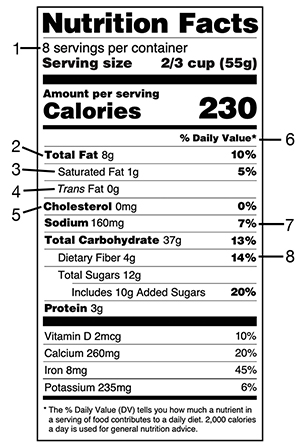Look for the Nutrition Facts label on packaged foods. Reading labels is a big step toward eating healthier. The tips below help you know what to look for.
-
Servings. Read this closely because the package, jar, or can may contain more than 1 serving. This is how to measure 1 serving of the food in the package. If you eat more than 1 serving, you get more of everything on the label — including fat, cholesterol, and calories.
-
Total fat. This tells you how many grams (g) of fat are in 1 serving. Fat is high in calories.
-
Saturated fat. This tells you how much saturated fat is in 1 serving. Saturated fat raises your cholesterol the most. Look for foods that have little or no saturated fat.
-
Trans fat. This tells you how much trans fat is in 1 serving. Even a small amount of trans fat can harm your health. Choose foods that have no trans fat.
-
Cholesterol. This tells you how much cholesterol is in 1 serving. For many years, it was recommended to eat less than 300 milligrams (mg) of cholesterol a day. New guidelines have removed this limitation. That's because dietary cholesterol has been shown to not raise blood cholesterol levels as much as once thought. But many foods high in cholesterol are also high in saturated fat. It is recommended to limit saturated fat in your diet.
-
% Daily value. The higher the number, the more 1 serving has of that nutrient. Look for foods that have low numbers for added sugars, total fat, saturated fat, and sodium. Foods that are higher in fiber, vitamins, and minerals (such as iron and calcium) are good choices.
-
Sodium. This tells you how much salt is in 1 serving. Choose foods with low numbers for sodium.
-
Dietary fiber. This number tells you how much fiber is in 1 serving. Foods that are high in fiber can help you feel full. They can also be good for your heart and digestion. The recommended daily amount of fiber is 25 grams for women and 38 grams for men. After age 50, your daily fiber needs drop to 21 grams for women and 30 grams for men.
Limit the amount of added sugars, fat, saturated fat, trans fat, and sodium. Eating too much of these may increase your risk of certain chronic diseases like some cancers, heart disease, and high blood pressure.


